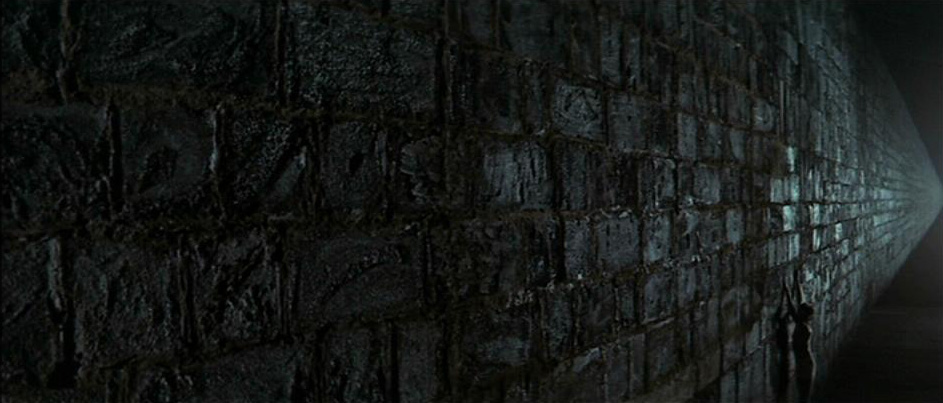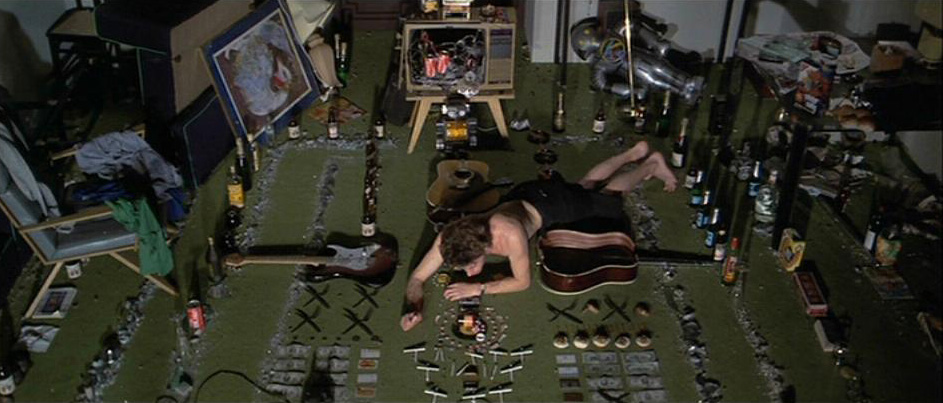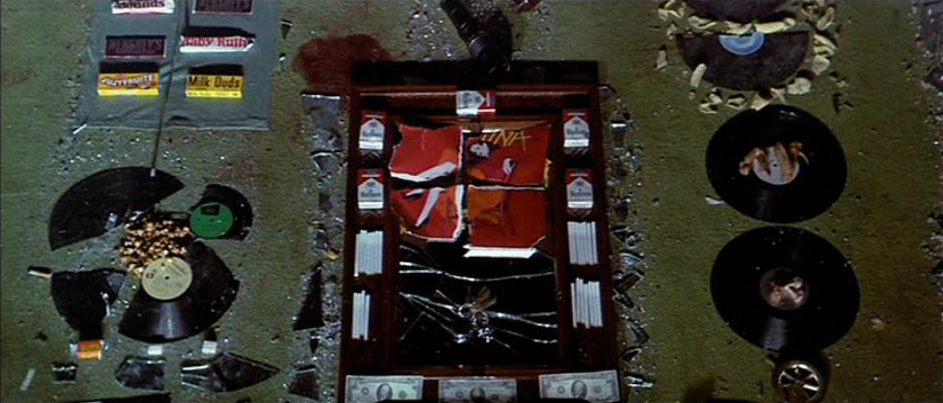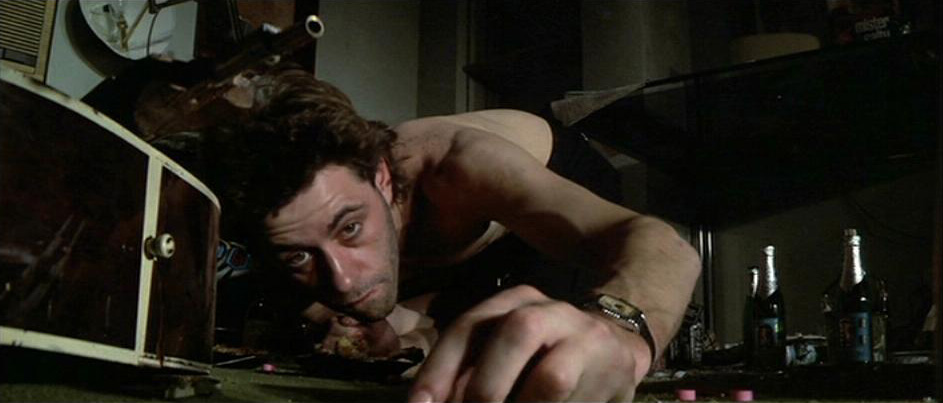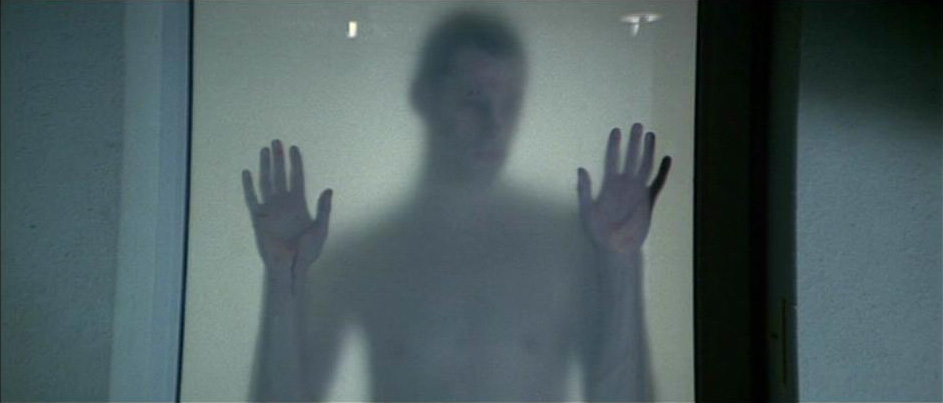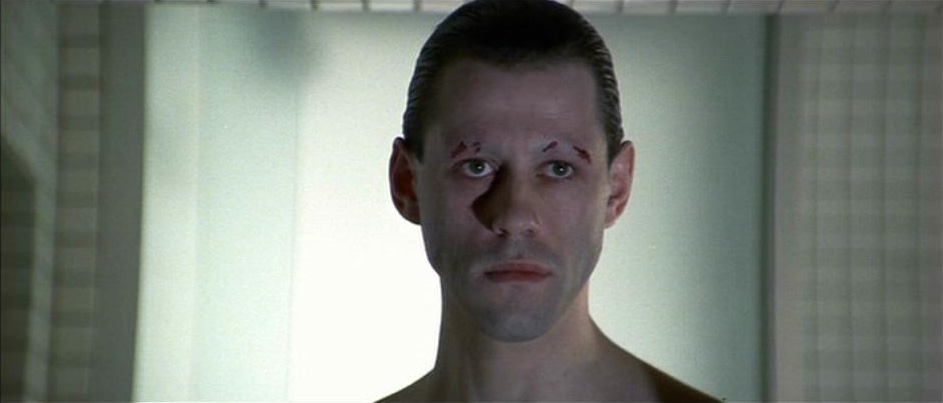Is There Anybody Out There?
[Roger Waters]Is there anybody out there?
Is there anybody out there?
Is there anybody out there?
Is there anybody out there?
Song In A Sentence:
In questioning whether anybody is out there, Pink begins to realize the expansiveness of his wall and the consequences of his self-imposed reclusion.
D on’t let the lyrical simplicity fool you. “Is There Anybody Out There?” is just as complex musically and visually as the rest of the album and film. Rare is the song that can create such an atmosphere with so relatively little – namely a handful of sound effects and a single lyric repeated with various intonations culminating in a haunting classical guitar melody set over a mood-perfect orchestral arrangement. In less than three minutes, six words, and with a certain minimalism that stands in stark contrast to the later, theatrical portions of the album, Pink Floyd manage to convey Pink’s ever-fracturing psyche, the expansiveness of his wall, and his growing realization as to the serious consequences of absolute disconnection from the world.
Regardless of whether one prefers the album track listing complete with “Hey You”, or the film’s in which the current song acts as the opener for the second half directly following “Goodbye Cruel World,” both narrative arcs find Pink newly cognizant of the totality of his creation. As the leftover strains of “…we fall” from “Hey You” echo out of existence, the sounds of traffic and Pink’s television take their place even before the oppressive, low notes of the synthesizer creep in. Rather than a World War II movie, the song fades in with Pink watching the 1967 episode “Fandango” of the Western series Gunsmoke. Coincidentally enough (or perhaps purposefully), according to the tv.com summary this specific episode of Gunsmoke is about how Matt Dillon’s attempts to bring a guilty man to justice are hindered by a crazed sheep rancher. While it may be stretching things to suggest that there is a direct correlation between Pink’s present and this particular episode, it is nevertheless interesting that the episode Waters used should deal with something like the inevitablity of justice.
A synthesizer swells over the television dialogue with a low bass chord, looming over the listener much like the wall in front of Pink. Waters begins the first iteration of the question alone, but is joined partway through the question (“…out there?”) by a chorus of voices, aurally suggesting that, much like the duo of singers in “Hey You,” Pink’s mind is splintering into various parts and personas in the shadow of his wall. Each time through, Pink asks the same question with different emphases and intonations, giving each reiteration a slightly different nuance. The first time, Pink’s question sounds like just that, a straightforward question, almost as if he’s testing the permeability of his bricks. A tinkling noise reminiscent of dripping water suggests the barrenness of his confines while a synthesized, modulating siren goes off like a red alert in Pink’s mind. Receiving no answer, the second repetition of the question is more hurried, worried even, and is punctuated by a shrill, warbling pitch riding the line between anguished scream and crazed laughter, both of which could easily apply to Pink’s divided mental state. The third time through, Pink pauses before really emphasizing “out there,” uncertain perhaps that anyone on the outside has noticed or even cares about this tortured rock star’s self-centered isolation. The same worm-like buzzing from “Hey You” fills the mix, alternating between the left and right speakers to symbolize the mental decay that encompasses Pink on all sides. The chorus of voices swell in harmony, the worms teem, the tortured scream / maniacal laughter sounds again, and for the last time Pink doesn’t so much ask as state “Is there anybody out there,” sounding completely resigned to the reality of his confinement.
In the same way that Pink’s previous emotional outbursts and attempts at individuality were musically expressed by David Gilmour’s guitar solos, the calm, almost detached classical guitar bit in the second half of “Is There Anybody Out There?” perfectly encapsulates his momentary surrender to the seeming impenetrability of his fortress. In his 1979 interview with Tommy Vance, Waters described the song as “a mood piece.” The atmosphere created by the solitary classical guitar backed by a restrained orchestra is one of total solitude hinting at introspection. With no answer from the outside, and no apparent chink in the bricks themselves, Pink is left with no other alternative than to turn inward, to regress further into his own psyche, as he will do often enough throughout the second half of the album.
Just as the song began with traffic and television, so, too, does it end, though this time with an audio clip from the military-related (back to that theme) comedy series Gomer Pyle, U.S.M.C. Yet cutting through Sgt. Carter’s dialogue is what can be interpreted as a symbolic battle of selves, with what sounds to be the scream of a little child – possibly the innocent childhood self he’s nostalgically glanced back on – cut off by his current, deranged self aggressively shouting “Shut up! I got a little black book with me poems in it!”
After a bit of “symbolic scrabbling” against his metaphoric wall in the film, as Waters put it during the DVD commentary, the scene fades to the ruins of Pink’s hotel room, the detritus of which has now been neatly ordered in complex designs. Out of all of the sequences in the movie, this particular scene seems to confound viewers the most, leaving them scratching their heads and wondering what it is exactly that Pink is constructing. On the DVD commentary, Gerald Scarfe recounts that this scene came out of talking about “what you do when you’re going off your head.” It very much speaks to the nature of the human mind that even a “normal” mind (whatever that truly means) searches for familiar shapes in clouds, phonetic messages in rock songs played backwards, recognizable forms in Rorshach ink blots, or ghostly faces in window reflections in blurry, pixellated photographs – it’s all part of a psychological phenomnon known as pareidolia (also commonly known as matrixing). This inherent need to create order out of the random is only amplified in the minds of those suffering from various nueroses. Many schizophrenics often “detect” patterns in the world around them, from what people say to the movements of nature. Similarly, many try to inject their own sense of structure into their chaotic lives, a structure that they alone might understand but that still allows them to feel as if a haphazard life is manageable. To borrow another line from the DVD commentary, it’s “trying to make sense out of chaos” when often there is no sense to be made. In much the same vein, Pink’s obsessive organization also speaks to his dichotomous rebellious / passive personas. Like the rioters, one part of Pink’s personality (the rebellious “I don’t need no arms around me” part) trashes his hotel room in a fit of rage; yet like the policemen who try to restore order, another side of Pink’s psyche (the persona concerned with the rules and social morals ingrained in him by the school teacher and his mother) steps forward and attempts to produce a systematic, organized whole out of the clutter.
Yet these polar sides won’t continue warring within Pink for long. As the last notes fade away, the scene changes to show Pink shaving in the bathroom. After finishing with his face, Pink lathers himself with shaving foam and shaves his chest clean of hair. Unconcerned with the blood that dribbles from the cuts on his chest, he next opens the razor and splits it in two before the shot is replaced by that of blood dripping into the sink. A hazy outline behind the condensation-covered glass, Pink presses himself to the bathroom door, then pulls it aside revealing his new incarnation. He emerges from the bathroom (another metaphorical womb) relatively hairless, a symbolic newborn created out of the decay of his isolation. It is in this metaphorical rebirth that the two previously warring sides of Pink’s personality (rioter / orderer) begin to merge into a new monster, Pink’s most frightening alter ego yet.
There is a bit of a biographical note to the infamous shaving scene, linking (albeit loosely in the context of the song) the drug-addled adult Pink with the band’s original frontman. In a story that would come across as apocryphal if it weren’t so well documented by the members of Pink Floyd themselves, the band recounts noticing an overweight man standing quietly in the back of the studio as they recorded their album Wish You Were Here in June of 1975. At the time they were working on “Shine On You Crazy Diamond,” a song about lead singer / song writer, Syd Barrett, who had been dropped from the band seven years prior due in great part to his increasingly erratic, drug-induced behavior and seclusion. Coincidentally, the portly man at the back of the studio was none other than Syd Barrett himself, unrecognizable to the band for some minutes partly because of his weight gain, and partly because he had shaved off all of his hair, including his eyebrows. Keyboardist Rick Wright later told an interviewer: “I saw this guy sitting at the back of the studio…and I didn’t recognise him. I said, ‘Who’s that guy behind you?’ ‘That’s Syd’. And I just cracked up, I couldn’t believe it… he had shaven all his hair off… I mean, his eyebrows, everything… he was jumping up and down brushing his teeth, it was awful…Roger [Waters] was in tears, I think I was; we were both in tears. It was very shocking… seven years of no contact and then to walk in while we’re actually doing that particular track. I don’t know – coincidence, karma, fate, who knows? But it was very, very, very powerful.” After a bit of odd behavior and telling the band that the song they were working on sounded “a bit old,” Barrett walked out of the studio, marking the last time some of the Floyd bandmates would see their original frontman.
That the band was referencing Barrett’s shaved-eyebrow look in their Wall protagonist is undeniable. Syd was no doubt in Waters’ mind as he crafted the adult Pink, a rock star whose pained past (at sixteen, Barrett also lost his father, though to cancer rather than war) and psychotropic drug use lead to a mental breakdown and self-imposed isolation from society. Yet there the similarities end; for while Barrett mostly receded into relative obscurity following his crackup, Pink’s metamorphosis propels him to new, delusional heights (or rather, lows). From his own anti-Christological blood and the sharp (ie, violent) edge of a razor, Pink the Dictator is conceived. Expressionless in his gaze, almost alien without eyebrows, Pink’s symbolic act has disconnected him that much more from the unanswering world and the humanity that could ultimately tether him to reality.
What Other Floydians Have Said
"Concerning the thing Pink was constructing in 'Is There Anybody Out There?' I believe that it wasn't any thing or shape in particular, but rather something to show his need to live an ordered and organized (up to the point of mania) life. I'm sure you recall the absolute chaos of his apartment at the start of 'Don't Leave Me Now.' For Pink to transform this into a painfully accurate design shows the fragile and tenuous state he was in. Moving a Coke can a few centimeters, replacing the guitar neck he knocked, seems silly to anyone else, but to Pink, it was not only necessary but essential to have it perfect." - Gogul Leviathon
"There is perhaps another possibiity for Pink's behavior in the movie during 'Is There Anybody Out There.' Having watched the behavior of my two kids, they went through a phase, and are actually still in that phase (ages 4 and 6), where they seem compelled to arrange things (usually their toys) in neat orderly lines or rows, usually on their nightstands, or on the floor, or even next to (yes) the wall. Perhaps Pink has regressed to a childlike state that causes him to engage in this same compulsive type-A behavior, as a child who is attempting to order his world. (Pretty much what you already wrote, but from the perspective of a regressed child.)" - David Tribble
"I noticed while watching the movie segment for 'Is There Anybody Out There?' the little order thing Pink makes out of the junk in his room, in my mind, looked something like a military camp." - Matt Hamm
Author's Addendum: If this is the case, it's a bit ironic that when Pink tries to order his life, it all comes back to the military and his father's death...arguably the first brick in his wall.



